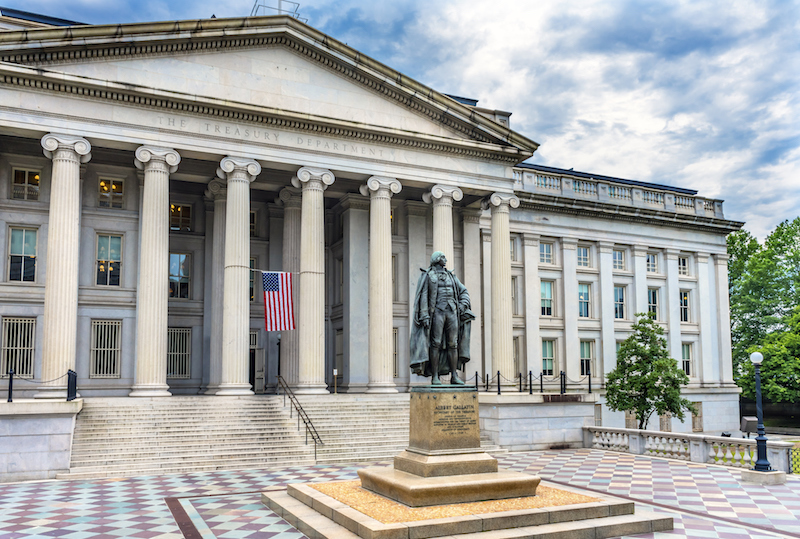
The Treasury Department should follow key principles in conducting its review of regulations.
Almost eight years after passage of the landmark Dodd-Frank Wall Street Reform and Consumer Protection Act, an examination of post-crisis reforms is appropriate and could be beneficial. But to succeed, any review effort must stick to certain core principles: It must be grounded in fact, be mindful of policymakers’ historic inclination to weaken regulation in prosperous times to the economy’s later detriment, and recognize that a resilient financial system is fundamental to sustainable economic growth.
Although the U.S. Department of the Treasury’s ongoing review, as ordered by President Donald J. Trump, contributes meaningfully to the conversation on financial reform and makes several important suggestions, it risks falling short on meeting these overarching principles.
First, the impetus for much of the Treasury Department’s efforts appears to be anchored to a claim that post-crisis reform has dampened economic growth and reduced market liquidity and that rolling back the rules would somehow help unleash the American economy.
Data do not support this narrative. In fact, the U.S. economy is in its third longest expansion in history and growing at a robust pace; unemployment is at a 17-year low; overall loan growth at U.S. banks has exceeded nominal GDP growth; bank net incomes are at an all-time high, excluding one-time charges from the recent tax reform; and market liquidity—the ease of exchanging assets for cash—remains ample according to all traditional measures.
Indeed, as Paul A. Volcker, former Chairman of the Board of Governors of the Federal Reserve System noted during a 2017 speech at the International Monetary Fund, “Claims that Dodd-Frank and other regulatory approaches have somehow gravely damaged the effective functioning of American financial markets, the commercial banking system, and prospects for economic growth simply do not comport with the mass of the evidence before us.”
Second, the Treasury Department should be even more heedful of the historical context.
U.S. monetary history is replete with instances of policymakers weakening regulation during good times only to later endure the painful consequences. As outgoing Federal Deposit Insurance Corporation Chairman Martin Gruenberg observed in a recent speech, “History…shows that the seeds of banking crises are sown by the decisions banks and bank policymakers make when they have maximum confidence that the horizon is clear.” With inflated asset prices, record levels of debt, the prospect of normalizing interest rates, and substantial market volatility, now is the time to avoid making this mistake again.
Yet it is not clear that we will. The Treasury Department’s suggestions would exempt several important banks from stringent prudential standards, dilute capital and liquidity requirements, reduce the frequency and strength of stress tests, and roll back important reforms to securitization and over the counter (OTC) derivatives markets. They would also allow banks greater opportunities to engage in risky proprietary trading and impair regulators’ ability to appropriately regulate systemically important nonbank financial institutions like the insurance company American International Group.
The Treasury Department’s recommendations appear to overlook a fundamental principle: A stable, resilient financial system is a precondition to sustainable economic growth. As Sir Paul Tucker, Chair of the Systemic Risk Council and former Deputy Governor of the Bank of England recently observed, “Choice, efficiency, and economic growth are hard to maintain if an economy cannot rely on the availability of core financial services through thick and thin.”
A more productive way forward would preserve the core pillars of financial reform, confront the weaknesses in the financial system, and eliminate unnecessary regulation, particularly on small community banks. Many different approaches are possible, but policymakers should strongly consider the following techniques, which are detailed in two reports from the Volcker Alliance as well as in various Volcker Alliance working papers.
- Reshaping the regulatory framework. The U.S. financial regulatory architecture is disjointed and balkanized. Having too many different regulators creates inefficiencies and increases costs for regulated institutions. It also prevents regulators from gaining a full understanding of the financial markets and addressing threats to systemic stability. Although the Treasury Department acknowledges some of the shortcomings, it has not proposed a plan for reorganization.
- Strengthening capital and liquidity requirements for large banks. The failure or distress of a systemically important bank can reverberate throughout the financial system and damage the economy. To mitigate this risk, banks should be able to withstand a major financial shock. This means that banks must be funded with sufficient amounts of loss-absorbing capital and hold ample easy-to-sell assets. Retreating from these requirements, including by weakening stress testing and making it less frequent, would undermine systemic stability.
- Renewing efforts to address the risks of short-term funding markets. Instability in the short-term debt markets, which include such arcane instruments as repurchase agreements, securities lending and borrowing, and commercial paper, lay at the heart of the last crisis. Despite some reform efforts, weaknesses persist in these markets, and further scrutiny is warranted.
- Strengthening clearinghouses for OTC derivatives. Clearinghouses—financial institutions that interpose themselves between buyers and sellers in OTC derivatives transactions—have become increasingly important since the central clearing mandate was enacted as part of Dodd-Frank. Yet clearinghouses lack a viable regulatory framework. Policymakers should develop that framework, taking into consideration new types of risks like cybersecurity and ensuring a viable resolution process. Although the Treasury Department acknowledges the importance of strengthening clearinghouses and makes some important proposals, it should go further.
To be sure, no financial reform package would be complete without relief for community and regional banks. Thankfully, Congress has taken up the cause of easing such burdens as part of S.2155, The Economic Growth, Regulatory Relief and Consumer Protection Act. The bill, which advanced within the U.S. Senate last December and will soon be taken up by the full Senate, includes many provisions helpful to community banks, such as simpler capital requirements, an extended examination cycle, and less complicated call reports. But in the interest of enhancing financial stability and reducing moral hazard, Congress should consider alternatives to certain of the bill’s provisions.
For instance, instead of raising from $50 billion to $250 billion the asset threshold at which banks begin to face increasingly stringent prudential standards, Congress should consider raising the threshold to, say, $100 billion and build greater flexibility for regulators in implementing those standards. This would prevent a blanket exemption for 25 of the 38 banks to which these standards apply, but still allow some measure of regulatory relief.
Congress should also consider eliminating a provision in the bill that would have the effect of reducing leverage capital requirements for the largest custodial banks, institutions that specialize in safeguarding the assets of their clients, including pension funds, mutual funds, and other institutions. Instead, regulators should study the need for such relief and, if advisable, use their already-broad authority to propose any necessary adjustments. This would prevent a procyclical reduction in capital requirements for some of the most important banks globally and spare Congress the pressure of providing similar relief to other banks.
Finally, Congress should consider an alternate approach to the bill’s exemption for small banks from the Volcker Rule ban on proprietary trading. Under this approach, community banks would be free from having to demonstrate compliance with the rule, but regulators, as part of their normal supervisory process could still detect persistent violations and, if necessary, seek remediation. This approach would have the advantage of preventing the federal bank “safety net” from being used to profit from risky proprietary trading activity.
Regulatory relief in the United States can be beneficial if it is principled. In its review, the Treasury Department would do well to consider important facts about the U.S. economy, bear in mind the mistakes regulators have made in the past, and strive to preserve the pillars of reform necessary to have resilient financial institutions and markets. On the legislative front, Congress should consider the modest changes highlighted above to further strengthen what is an impressive bipartisan effort to ease the regulatory strain on community banks.




